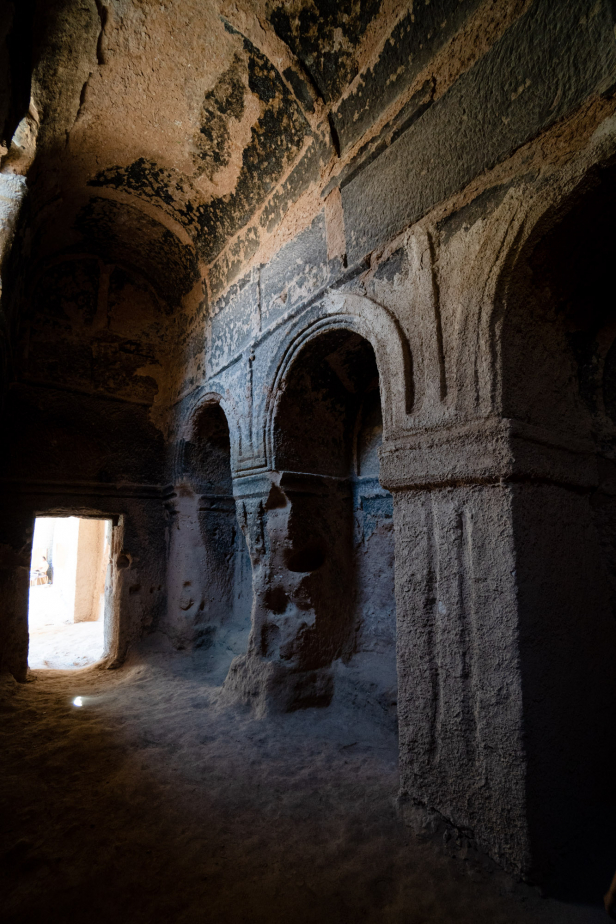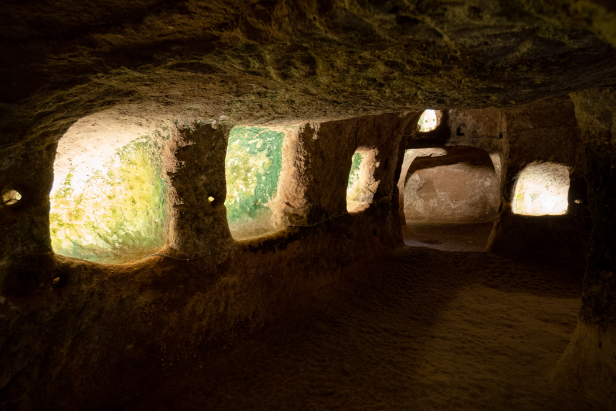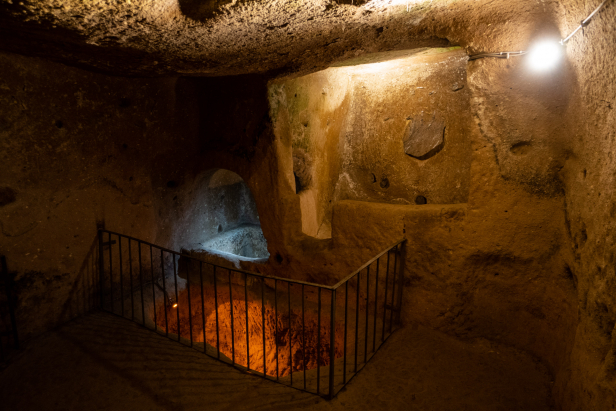Belha Monastery and Özkonak Underground City
/ By Josh
The village of Özkonak sits in the midst of a rather undramatic landscape. While just across the Kızılırmak River Göreme National Park, with its soaring spires of rock and magical valleys, Özkonak’s attractions are hidden beneath the ground.
Why Visit?
Belha Church
(Belha Kilisesi)
Cost: Free
(While donations are accepted, they are not required)
The site known as the “Belha Church” is actually a large complex with a set of large halls and a church centered around a wide courtyard. While it’s entirely possible that the complex was a monastery, it is also possible that it was the residence of a wealthy local who had the church built alongside the other rooms. The site has not been thoroughly studied and the exact date of its origin is still uncertain with estimates ranging from the 4th to 8th centuries AD. In design it is quite similar to the complexes of nearby Açıksaray which has also been the subject of debate with no consensus on whether it was a monastery, palace, or military site.

Subscribe to The Art of Wayfaring
The courtyard and complex in general is cut into the slope of a hill running down from the north to the south so that the south side of the courtyard is little more than a low berm while the north side is a high wall. On the north side three large arches have been carved into the rock, though the pillars you see today are modern reconstructions, built to restore the original and keep the roof from collapsing. Behind this set of arches runs a wide vaulted aisle from which the main hall opens on the north side and the church is entered on the east.
The church was carved out of the rock as a long narrow aisle topped by a high vaulted roof ending in a deep set apse. Into the sides deep, vaulted niches have been carved giving the church the appearance of a pillared hall, with fine moldings and carved crosses making it the finest portion of the complex.

Off of the north hall (directly behind the vaulted arcade) is a rather unusual, long, curving tunnel leading to a simple chamber. A local who stands at the entrance of the complex collecting tips and selling stone jewelry advertises it as bio-energy healing room and offers energy healing treatments there.
The church and complex are at the end of a narrow gravel road with no room for busses to turn around, ensuring that the larger groups won’t flood the site and that it stays a bit quieter than many other sights in the area.
Özkonak Underground City
(Özkonak Yeraltı Şehrı)
Cost: 50TL
(Museum Pass and Cappadocia Museum Passes accepted)
There are some 200 underground cities in Cappadocia, ranging in size from true cities that can hold tens of thousands, to others that are more akin to underground villages. Özkonak underground city is more on the small side compared to the mammoth Derinkuyu and Kaymaklı underground cities though currently only a portion of the tunnels have been opened to visitors.
The history of Özkonak Underground City is not well known and is instead understood in the context of the other underground cities in the region. The earliest stages of these underground settlements are believed to have begun sometime in the Bronze Age, between 2000 and 1300 BC during the time of the Hattian and Hittite rule. At this time simple stables and chambers near the surface were carved near the surface. The underground dwellings made a good escape from the heat of summer and the freezing cold of winter.
Subscribe to The Art of Wayfaring
Over the centuries these simple spaces were expanded and became vast networks. By the 5th century BC the Persians noted the peculiar practice of the Cappadocians to build cities underground. The underground cities became a unique form of fortification for the Cappadocians who, instead of relying on strong walls, dug deep, hiding their numbers underground and disguising the entrances to their subterranean towns inside of houses and stables. Heavy millstone doors and booby traps kept out invaders while ventilation shafts, hidden wells, and food kept the people safe from raiders above ground.
Özkonak Underground City has all the trademarks of a Cappadocian underground city with narrow tunnels, tubes for relaying messages between chambers, wells, air shafts, millstone doors, as well as a deep shaft with carved handholds.
How To Get There
Where To Stay
The village of Özkonak is only 17 kms from the center of Cappadocia, one of Turkey’s most popular destinations. With the tourism comes an incredible list of hotel options to choose from. The village of Özkonak itself is home to a lovely boutique hotel, and many of the towns and villages of Cappadocia will have a quaint hotel or two to choose from. The towns of Ürgüp, Göreme, Ortahisar and Üçhisar are home to fantastic cave hotels and boutique hotels in romantic stone houses with stunning views of the alien landscape. If you want to wake up to hot air balloons outside your window, then Göreme may be your best bet. There are also plenty of campgrounds to choose from in the area, and, for a small fee you can always arrange to pitch a tent in a local’s field.
Other Tips
Planning on visiting Özkonak Underground City and Belha Church? Make sure to check out our guide to the Göreme National Park and our other Cappadocia Guides.
Subscribe to The Art of Wayfaring
Have any tips or info to add? Spot any mistakes? We’d love to hear about it.


